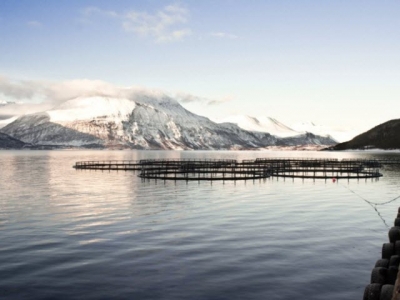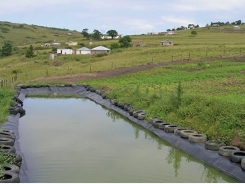Probiotics may offer Atlantic salmon, trout protection against cold-water disease

A probiotic treatment may help protect salmonid species from cold-water disease, say researchers.
In addition to the on-going hunt to find a vaccine for the disease, researchers are also seeking a natural way to prevent it, said Douglas Call, professor of molecular epidemiology at Washington State University.
Call has been working with a group that includes Ken Cain, professor and associate director of aquaculture at the University of Idaho. The research group has been studying cold-water disease, also called rainbow trout fry syndrome, for about 15 years. The team is developing probiotic protection against it.
The group has been examining methods to better understand the way the probiotic treatment works and how it interacts with the fish’s immune system, Call told FeedNavigator.
They also are planning to examine how exactly the protective toxin produced by the bacteria involved interacts with cold-water disease if it has been injected into the fish, he said
The research would seek to discover how the fish brings the toxin and the disease-causing bacteria together internally, and if the biome of the fish is being altered in the process, he said. The knowledge could lead to new approaches to improving fish health, said Call.
Why cold-water disease?
The disease affects species like salmon and trout and has been a finical burden to the aquaculture industry, said Cain.
“Coldwater disease probably causes greater mortality than any other disease in trout and salmon hatcheries in the [US] Pacific Northwest and it’s a huge problem in other countries, where it primarily affects commercial trout and salmon aquaculture, which makes it an expensive disease for producers,” he said.
The disease is caused by Flavobacterium psychrophilum, researchers said. The bacterium promotes septicemic infection in young fish and is often fatal. In older fish it can lead to economic damage from treatment expense and degradation of their value.
There is no commercial vaccine for the disease, they added.
Project details and expansion
Part of the team working at Dr Cain’s laboratory discovered that a common bacteria found in fish could be used to protect them against the disease if added to their food, said Call. Once the bacteria was identified the group sought to determine how the bacterium helps protect fish against the disease by isolating the toxin it generates that appeared to be protecting the fish and testing its effectiveness by removing it from the feed additive.
By removing the probiotic’s ability to produce the toxin, then testing the effectiveness of what remained, researchers could determine if it was the toxin that protected the fish, said Call. The work demonstrates the “cause and effect” of the probiotic, he added.
The team wants to develop the probiotic for the aquaculture industry, added Cain. They also are continuing to develop a vaccine for the disease.
“There’s a big market for control measures for products that could control or prevent this disease because it’s such a world-wide problem,” he said.
Disease treatments and damages
“Improved rearing conditions (including stress reduction, reduced stocking densities, cleaner raceways, adjusted feeding strategies, and improved disinfection protocols) and antimicrobials are the only practical control measures,” the researchers said. “In the US, oxytetracycline and florfenicol are approved for treatment of BCWD, but drug resistance may be emerging, and concerns about the environmental impact of these treatments make it imperative to find new strategies.”
The global production of salmonid species is more than 2.9 megatons and around $13.7b a year, researchers said.
Research details
In the most recent research published in the January 2015 edition of Applied and Environmental Microbiology the group took the enterbactor strain C6-6 and tested the effectiveness of portions on preventing flavobacterium psychrophilum, which causes cold-water disease, stated the researchers.
In the trial, groups of rainbow trout were fed portions of enterobacter C6-6 (C6-6) from which the toxin suspected of preventing the disease were removed, a strain in which the toxin had been returned and the wild C6-6.
Fish were split into five groups where they received a commercial salmonid diet and one of the supplements for 38 days and on day 11 they were injected with F. psychrophilum, they said. One control group did not receive any probiotic and another control group was not challenged with any disease.
“Fish that were fed C6-6 had significantly longer survival than fish fed the ecnAB knockout strain, while fish fed the complemented knockout strain recovered the probiotic phenotype,” researchers concluded. “This entericidin is responsible for the probiotic activity of Enterobacter C6-6, and it may present new opportunities for therapeutic and prophylactic treatments against similarly susceptible pathogens.”
Fish that were given the original probiotic had a survival rate relative to the untreated control group of about 58.1% and those that received the probiotic where the toxin had been removed and returned had a relative survival rate of about 80.7%.
Fish that had the probiotic with the specific toxin removed had a relative survival rate of about 19.4%.
“Consistent with our hypothesis that ecnAB is requisite for the probiotic activity of Enterobacter C6-6, the mortality of fish treated with the ecnAB knockout strain was not different from that of the no-probiotic control group, while the group treated with the complemented strain was not different from the group treated with wild-type Enterobacter C6-6,” said researchers.
Antibiotic replacement
Probiotic protection also may offer a way to reduce the use of antibiotics in fish production, said Call.
“One of the key take home messages is we can address disease problems in aquaculture and agriculture, it just takes investment, and we [will] have less use of drugs like antibiotics,” he said. “This is just one example.”
Có thể bạn quan tâm
Phần mềm

Phối trộn thức ăn chăn nuôi

Pha dung dịch thủy canh

Định mức cho tôm ăn

Phối trộn phân bón NPK

Xác định tỷ lệ tôm sống

Chuyển đổi đơn vị phân bón

Xác định công suất sục khí

Chuyển đổi đơn vị tôm

Tính diện tích nhà kính

Tính thể tích ao hồ



 Encapsulated yeast strain could boost immune response in…
Encapsulated yeast strain could boost immune response in…  A better way to do aquaponics
A better way to do aquaponics